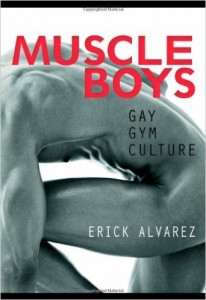 Muscle Boys: Gay Gym Culture
Muscle Boys: Gay Gym Culture
by Erick Alvarez
Harrington Park Press. 304 pages, $19.95
PLANTED MODESTLY in the middle of this new study is its pithiest assertion: “Simply put, in urban America, being gay comes with a gym membership.” Of course this is an overstatement, but it expresses the extent to which working out has become a significant part of everyday life for many gay men. Other writers, including Michelangelo Signorile and Daniel Harris, have criticized gay muscle culture for its triviality, narcissism, and exclusiveness. Erick Alvarez wants to counter the gym-bashers by showing that gay men who go to the gym—far from being uniformly polished, pumped, young, and egotistical—are a diverse group, who use the gym for socializing, mating, and improving their health, as well as for æsthetics. He supports his argument with interviews and surveys of gay gym-goers, as well as his own experience as a personal trainer in San Francisco.
Alvarez’ study leads him to distinguish six different, overlapping categories of gay gym users: HIV-positive men or “poz jocks”; athletes; circuit boys; muscle bears; older males (over forty!); and a miscellaneous group of “regular guys” who don’t identify with any group—these are the “muscle boys.” Actually—and a bit confusingly—this is also the umbrella name for all men who participate in gay gym culture, which points to one of this book’s problems. Granted, many adult men, both straight and gay, refer to themselves and their peers as “boys,” but Alvarez adopts this usage uncritically, even though his subjects include men in their sixties and seventies, and he himself warns against the isolating effects of ageism in the gay community.
While it’s not surprising to hear a strong defense of the workout scene from a man who makes his living from it, it’s also refreshing to find a different take on that scene after the negative assessments of writers like Michelangelo Signorile. Alvarez offers a stream of testimonials from gay men who have made life-changing gains in self-esteem, well-being, and health by making the gym a regular part of their lives. Still, his defense of gym culture against the charge of superficiality often sounds rather superficial itself. For example, he convincingly counters the claim that body dysmorphia is what drives most gay men to exercise, but when he seeks to explain what does impel circuit boys to adopt training regimens rivaling those of professional athletes, his answer is simply that it’s human nature to evaluate people on the basis of looks and to compete for the title of Most Beautiful. Only briefly do we glimpse the darker side of this glibly upbeat world, when one stunner of a circuit boy admits that his gym obsession stems from low self-esteem and a yearning for attention.
As part of his project to defend muscle boys from their detractors, Alvarez attempts to show that they have an honorable cultural pedigree. He spends several chapters tracing the intertwined histories of homosexuality and physical culture from ancient Athens through the rise of celebrity bodybuilders like Eugene Sandow (who may have been gay or bisexual). It may have been better for Alvarez to condense these first hundred pages into a single chapter that summarized the literature, because he does little more than recap his secondary sources. The historical survey pauses now and then for a strikingly original thought, such as Alvarez’ suggestion that gay men could reclaim the Greek ideal of arete (excellence or virtue) if their community were kinder and more supportive. But these moments are drowned out by jarring generalizations, such as the following: “Because homosexuality was a widespread practice by the culture of the Greek gymnasium as the Greek body ideal evolved … by and large the infamous Greek ideal can be defined as a homosexual concept.” (That misuse of the word “infamous,” by the way, occurs throughout the book, as does “urbane” in place of “urban.”) Or this: “Of course, life then was very different from what it is today, but by modern standards the Greek gymnasium was for the most part what we would call a gay environment, remarkably akin to the modern gay gym.” Alvarez makes history say what he wants it to say, thus weakening his credibility as an advocate.
The truly original part of this book—its lean muscle mass, as it were—is its analysis of contemporary gay gym culture, which includes an informative discussion of steroid use. Many readers will find this portion of Muscle Boys interesting and provocative if they can tolerate its awkward, repetitive prose. That requires quite a workout, given the countless sentences which go astray in mid-course, mismatched subjects and verbs, belabored points, and an irritating archness of style. Alvarez makes the intriguing suggestion that bear culture, with its disregard for body ideals, could bring a healthy balance to the gay gym ethos; but he calls the idea “a concept worthy of a big-bear-hug” and refers to bears patronizingly as “our furry friends.” In a chapter devoted to the topic of locker-room sex, after indulging in several mild penis jokes, he harrumphs that “this is a serious discussion undistracted by erotica.”
Alvarez clearly knows his territory, and he brings a physiologist’s training and experience to his reflections upon it. If more of this uneven book were as pointed and concise as its best sentences, we might have a more engrossing analysis of the meaning and power of the gym in gay men’s lives today.
____________________________________________________________________
Stephen Kuehler is a research librarian in Cambridge, Mass.





